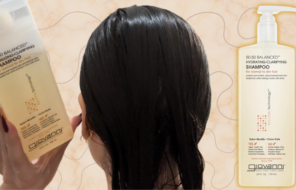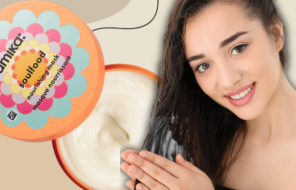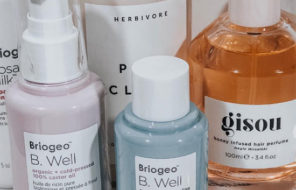Color-depositing shampoos are our favorite little time-savers. They do double-duty, acting as shampoos to clean the hair while also infusing each strand with some pigment. They come in all kinds of colors and with all kinds of different formulas.
In this guide, we will give all the important information you’ll need to know when shopping and using a color-depositing shampoo. We’ll explain exactly what a color-depositing shampoo is, as well as the different kinds of formulas. Then, we’ll give out top tips for how you should use a color-depositing shampoo, as well as how often.
In this article:
- What Is a Color-Depositing Shampoo?
- The Main Types of Color-Depositing Shampoo
- How to Use Color-Depositing Shampoo
- How Often to Use a Color-Depositing Shampoo?
What Is a Color-Depositing Shampoo?
If you can’t glean from the name, a color-depositing shampoo is a shampoo that can deposit color into your hair. In other words, it’s a unique shampoo formula that’s imbued with pigment. When you wash your hair with it, it also deposits some of that pigment into the hair, helping to dye or tint it, depending on the formula. There are also color-depositing conditioners that should be accompanied to condition your hair and make the toning process more efficient.
Color-depositing shampoos can’t lighten or totally dye the hair. Instead, they just deposit the color into it. This means that if your hair is naturally dark, a color-depositing shampoo won’t make much of a difference. On the other hand, hair that has already been bleached or dyed is more porous, so colors, even from shampoo formulas, can penetrate inside and transform it from within.
The Main Types of Color-Depositing Shampoo
There are three main categories of color-depositing shampoos. They’re all great, so it’s just a matter of which one will work best for your hair.
Coloring Shampoos
The most dramatic of the bunch are the shampoos that can actively color your hair. Their formulas are strongly pigmented, so they’re just a step or two below a typical semi-permanent dye.
They can be used in a few different ways: they can be used as a regular shampoo to keep dyed hair looking fresh. You can also use them on pre-lightened hair, and after a few washes, they’ll slowly and progressively dye the hair. Finally, you can use them as you would a semi-permanent dye to totally change your hair color.
They’re usually sulfate-free, which means that they’re not the best at cleansing the hair, but they can be left on for a while to give a stronger color.
Color-Enhancing Shampoos
Next, there are color-enhancing shampoos! These shampoos deposit enough color in the hair to keep it looking fine and fresh, but they’re usually not pigmented enough to dye the hair on their own. They usually have stronger cleansing formulas, either with or without sulfates, so they can be used regularly to clean the hair and give it a small color boost. If your hair is already dyed or you’re trying to keep your natural hair color from fading because of sun exposure, they’re a fabulous, easy-to-use choice.
Toning Shampoos
Finally, there are toning shampoos. They’re tinted with a color that’s meant to neutralize rather than totally change the hair color. Purple shampoos are a famous part of this category since they help to remove yellow tones from blonde hair to get it looking ashier or more platinum.
Toning shampoos also come in blue to counter brassy tones or in green to counter red tones. They don’t dye the hair the way a purple or blue coloring shampoo would, but instead, they deposit just enough color to neutralize and enhance.

How to Use Color-Depositing Shampoo
Using a color-depositing shampoo is not too different from using normal shampoo, although we still have a few tips to keep your experience more pleasant.
For a Quick Refresh
When you just need to reinforce your color lightly or to keep away unwanted tones, a quick wash is enough. If your shampoo is very pigmented, you might want to do all of this with gloves on to avoid staining your hands.
- In the shower, set the water to a lukewarm temperature since hot water is quite damaging to the hair.
- Next, wet your hair thoroughly, and then squeeze out the excess water.
- Pump out about a quarter-sized amount of color-depositing shampoo in the palm of your hand.
- Bring the shampoo to your hair, and massage it to work it into a lather. Make sure all of your hair gets massaged and covered with foam.
- Depending on the formula and the level of color boost you need, consider leaving the shampoo to soak into your hair for 3-5 minutes.
- Finally, rinse your hair to get rid of the shampoo residue and apply hair conditioner or a reparative hair mask.
- If there is any color residue in your shower or bathtub, make sure to rinse it away thoroughly and wipe away any stains with a sponge. If you leave it on a white tile for too long, it may stain.
Instead of Dye
Some color-depositing shampoos work beautifully as light, semi-permanent dyes. If you want such dramatic results, here’s how to use them.
- Start out with dry hair.
- Make sure to wear clothes that you don’t mind staining.
- Pump out a generous amount of color shampoo in your hand (wear gloves if your shampoo is likely to stain).
- Apply the shampoo to your hair, section by section.
- Massage it into each section of hair to ensure each strand is coated from all sides.
- Leave the shampoo in your hair for 5 minutes for a subtler tint and up to 30 minutes for dramatic color.
- Finally, hop in the shower and rinse out the shampoo.
- Follow it up with conditioner, and voila! Enjoy your new hair color.
How Often to Use a Color-Depositing Shampoo?
Ideally, you should use a color shampoo between once to a few times a week, depending on the formula and your hair type. The subtle color-enhancing formulas can be used more often, especially if the shampoo is sulfate-free and non-drying or if your hair is naturally oily and needs that deep cleansing.
On the other hand, the more pigmented color-depositing shampoos often give the hair enough of a color boost that using them just once a week is enough, while the rest of the time, you can use a gentle, sulfate-free cleansing shampoo.
Photos via @aquinomara, @hieucow





